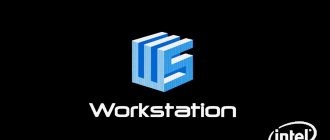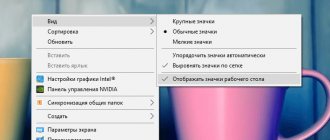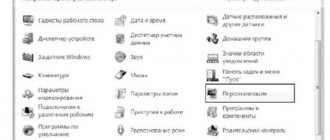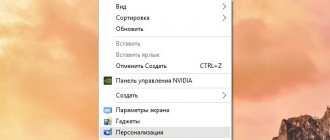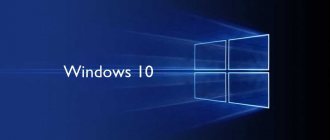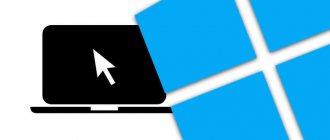Why does a black screen appear instead of the “Desktop” when Windows starts?
There are quite a lot of reasons for this phenomenon, but it is not always possible to say immediately what exactly could provoke such behavior of the system. In most cases, the problem of a black screen appearing instead of the “Desktop” in Windows 10 or other versions is usually explained by failures in the Explorer service, which is responsible for displaying the system’s graphical interface. Yes, indeed, this is partly true. However, one should not discount possible malfunctions of a video card with its missing or outdated driver, problems with damaged system components, and even viral effects. We won’t talk about viruses now, but will pay more attention to the parameters of the Windows operating systems themselves.
Instead of the Windows “Desktop” there is a black screen: what to do first?
First, let's consider the situation with user-changed Desktop settings, assuming that the graphical interface contains both the Start button, the Taskbar, and the system tray with the notification area, and not just shortcuts. No matter how trivial it may sound, the user himself could set not the wallpaper as a picture, but a regular black fill or, as in Windows 10, apply a high-contrast black theme.
The shortcuts could disappear only for the reason that the display of icons in the RMB menu on the “Desktop” was simply disabled. Check if this option is enabled. However, as practice shows, quite often the loading does not even reach the appearance of the “Desktop” with all its elements (although Windows seems to start without visible glitches and errors).
Desktop won't load [solution]
This article proposes a solution to the problem when, after turning on the computer, the system boot ends before the desktop is displayed. That is, there are no shortcuts, no taskbar, no Start button, and all you can see is a blank screen. Most often, this problem occurs as a result of viruses. A classic case: you scanned the system for viruses, the antivirus found something and neutralized it (deleted malicious files), after which the desktop stopped loading. Why could this happen? It's simple. The desktop is loaded by calling the explorer.exe file specified in the Shell parameter in the registry key: HKEY_LOCAL_MACHINE\SOFTWARE\Microsoft\Windows NT\CurrentVersion\Winlogon The virus changes the name of the file specified in the parameter to the name of its child application. This application does some of its dirty deeds, and then launches the desktop. However, what happens when the antivirus detects a virus? That's right, he neutralizes it, namely, removes it. However, it does not correct the registry setting that should launch the desktop. It turns out that the next time the system boots, a non-existent file is specified in the Shell parameter and there is simply nothing to load. That's why we see a blank screen. Thus, to restore the loading of the desktop, you need to specify the value for the Shell parameter: explorer.exe - the real name of the file responsible for loading the desktop.
So, we have a blank screen. Press the key combination “Ctrl+Shift+Esc” to open the task manager. In it, go to the “File” menu -> “New task (Run)”. In the Create a new task window that opens, in the Open field, enter: regedit.exe and click “OK”. The Registry Editor should open.
In the Registry Editor window, go to the section:
HKEY_LOCAL_MACHINE\SOFTWARE\Microsoft\Windows NT\CurrentVersion\Winlogon
In which we find the Shell parameter. Double-click on it with the left mouse button, the parameter editing window will open, correct it to – explorer.exe and click “OK”.
Close the registry editor (by clicking on the cross in the right corner of the window). Press “Ctrl+Shift+Esc” again, then in the task manager go to “File” -> “New task (Run)”, enter explorer.exe and click “OK”. If the desktop has loaded, reboot the system and check that when loading, the desktop appears with icons, a taskbar and a Start button. If everything has loaded, congratulations! Your torment is over now.
If the desktop does not load, then you are out of luck; your case is more complicated. Some viruses do not specify their child application in the Shell parameter; they simply replace the explorer.exe file with their application! The real explorer.exe is renamed to some name only known to the virus, and a fictitious one is placed in the place of the real file. Accordingly, we have: the antivirus detects the modified explorer.exe as a virus and, of course, deletes it. The next time you boot, the system accesses a non-existent file and, as a result, we see a blank screen.
In this case, you need to copy the original explorer.exe file to the C:\Windows\ folder. It can be taken from another computer with a similar system, or copied from the installation disk. On the installation disk, the file is located in the I386 folder and has the name: explorer.ex_ (instead of the last letter there is an underscore). It cannot simply be renamed because it is stored in a compressed state. To unpack the file, in the same I386 folder there is a utility expand.exe
An example of unpacking the explorer.exe file from the installation disk into the folder with the installed Windows system. Let's say we have: 1) drive “C” with the system installed on it; 2) disk “D” - CD with the system distribution kit. Then open the command line: “Ctrl+Shift+Esc”, then in the task manager go to “File” -> “New task (Run)”, enter cmd and click “OK”. In the black window that opens, enter the command:
D:\i386\expand.exe D:\i386\explorer.ex_ C:\windows\explorer.exe
(drive letters (C, D) may differ in your case)
This will simultaneously unpack and copy the desired file to the Windows folder. Now open the task manager window again and try to load the desktop (“Ctrl+Shift+Esc”, “File” -> “New task (Run)”, explorer.exe,”OK”). The desktop should appear.
What to do when booting the system?
If a black screen appears instead of the “Desktop” in Windows 7 and similar modifications when the system starts, it is quite possible that the GUI launch service itself is damaged. To begin with, when restarting, you can use a special boot menu (F8 in Windows 10 does not work), in which you select to load the last configuration in which working parameters and settings were saved. This course of action sometimes eliminates the problem. If this does not help, try setting a rollback via a forced shutdown and startup (it may take three or more times).
Note: to return the use of the F8 key in the tenth version of the system, you need to run the command presented in the image above on the command line.
If such a start is not possible, try booting with a safe start (Safe Mode).
Activating Windows 7 or how to remove the black screen from the desktop
Windows 7 activation has disappeared , the desktop background has become similar to the famous painting by the artist Malevich, a black square? in our case, a black screen. The reason for this problem may be that someone is using a pirated copy of the operating system, or a licensed one, but for some reason the Windows activation key has disappeared and needs to be entered again, but before that you need to do some steps described in this article .
When faced with this problem, you should not worry, because it can be solved with a small number of actions. Let's look at the question of why this happened. When automatically downloading and installing updates, one is downloaded that checks your system for authenticity; it is codenamed KB971033 . It is after it is installed that the background scan begins and the detection of a pirated copy of Windows begins.
After this, if there is an unlicensed version, a so-called black screen , which says that your copy of Windows is not genuine . If the system is licensed, but for some reason the screen turns black, it means the activation key has been lost and you will need to re-enter it, but after some steps.
First, you need to delete the downloaded update; to do this, go to the control panel.
System and safety.
Here we need to log into Windows Update.
In the right column at the very bottom, go to the installed updates tab.
And in the list we find what was mentioned above, namely the update for microsoft windows (KB971033). Right-click on it and click delete. But if this update is not listed, it may be hidden. Then we will need to enter the command line and try to get rid of it using a specific command.
Open the start menu, write cmd , right-click on the found file and run it as administrator.
In the line we write the following command wusa.exe /uninstall /kb:971033 and press the enter key. The update should be removed.
After uninstallation, so that this problem no longer bothers us, we will have to find this update using a search and hide it from re-installation, because after uninstallation, it can also be automatically downloaded and installed again. To do this, go to Windows Update and in the right column, click on the item search for updates .
We are waiting for this process to complete. You can have some tea for now.
After visiting the Windows Update Center, we will be provided with some important ones, where they are stored and those that need to be hidden. To do this, go to the important updates tab; as you can see, I have as many as 123 of them.
We find the ones we are interested in, right-click on it and select hide update. After it has disappeared, click ok. Now we can safely install the others provided, after which do not forget to restart the computer. Next, to fully activate Windows , you will need to perform a few more steps, which are described in the article Your copy of Windows 7 is not genuine. Assembly 7600,7601. For users whose operating system is installed in the GPT partition, I advise you to use another activation method, which is described in the article Unknown boot device harddiskvolume1 or how to activate Windows 7. Also for users of licensed operating systems who are faced with a black screen , this article will help, but instead of the activator, enter your license key again.
Leave your opinion about this article, and of course, ask your questions if something suddenly went wrong for you.
Thank you for your attention!
Articles recommended for reading:
- How to hide a folder in windows 7 an interesting way (3880)
- How to create a system restore point in Windows 7 (4153)
- How to Partition a Hard Drive Using Windows Tools (4235)
- How to restore your system using a restore point in Windows 7 (17778)
- How to Russify Windows 7 (13874)
- How to remove the entry in the boot menu Windows 7 Loader XE (41110)
- How to hide a system reserved partition in windows 7 (9124)
Would you like to thank the author? Share a link to the article!
How to restart the Desktop service?
But let’s see what to do when a black screen appears instead of the “Desktop” (or even a screen with an installed image, but without control elements) for any system boot option. Apparently, the user is dealing with malfunctions in the main GUI launch service. It must be started manually. To begin, you can call the “Run” console (simultaneously pressing the Win + R key combination) and enter the explorer.exe command in it.
If the program launch menu does not open in this way, try calling the “Task Manager” using the familiar combination Ctrl + Alt + Del. Using the file menu, select creating a new task and run the above command. As a rule, when it is completed, everything falls into place. But you won’t have to start the process manually every time. If this is exactly the problem, and instead of the “Desktop” a black screen appears with enviable consistency, as an option, use adding the service to the startup section after first creating a shortcut for the executable file. But usually the reason lies much deeper, and it will be necessary to eliminate the consequences of system failures using more effective methods.
Editing the registry
Most often, the actions described above are one-time only. Thus, the machinations have to be repeated every time the system starts. To deal with the error, you need to restore the registry.
There are several ways to open Registry Editor. You can start a new task with the regedit command in the Manager or open the Start menu - Run
and write the same command there. In any case, the register opens in front of you.
In it you should find the path:
HKEY_LOCAL_MACHINE\SOFTWARE\Microsoft\Windows NT\CurrentVersion\Winlogon
In the folder that opens, find the Shell
.
explorer.exe
should be listed next to it .
Near Userinit
–
C:\Windows\system32\userinit.exe
.
If the actual values do not correspond to those described, they must be changed by clicking the right mouse button. It may be that the indicator is missing altogether. In this case it should be added. Right-click on an empty space in the window and Create a string parameter. Give it the required name and details. Restart your computer.
If this does not help, try removing explorer.exe
and
iexplorer.exe
. They can be found in the section:
HKEY_LOCAL_MACHINE\SOFTWARE\Microsoft\Windows NT\CurrentVersion\Image File Execution Options
Next, select a folder with the appropriate name explorer
or
explorer.exe
.
Follow the path:
HKEY_CURRENT_USER\SOFTWARE\Microsoft\Windows NT\CurrentVersion\
and make sure that the Winlogon folder (the intermediate path is the same) does not contain Shell
and
Userinit
. If you find them, delete them. Try restarting your PC again.
How to reinstall graphics adapter drivers?
Apart from the processor and RAM, when Windows starts, the video card is immediately used, which is responsible for displaying graphics. But problems with its operation, most often related to the driver, can lead to the appearance of a black screen instead of the “Desktop”. The conclusion is obvious: the driver needs to be reinstalled. This can be done either in safe mode or during normal boot after starting the Explorer service (not to be confused with Explorer). In Device Manager, simply use the desired line from the RMB menu or click the refresh button after calling the properties of the selected device.
If this does not help, remove the graphics adapter from the system entirely. After restarting Windows, it will try to install the required driver on its own. If this does not give any effect, update using narrowly focused applications (for example, NVIDIA Experience) or use general programs like Driver Booster for this. But to search for and install an updated or missing driver, you will need an Internet connection (without this, such applications simply do not work and, at best, produce errors).
What actions need to be performed in the registry?
Finally, let's look at what is considered to be the most effective solution. Call the registry editing tool through the run menu or “Task Manager” (regedit), in the HKLM branch, find the Winlogon section.
In it, pay attention to the Shell and Userinit parameters. The first key should be set to explorer.exe, the second should be the full path to the executable component Userinit.exe, which is located in the System32 directory of the main Windows folder in the system partition (on drive C). If such keys do not exist, create these parameters yourself. Similarly, search in the HKLU branch, and delete the above keys (if they are there). Upon completion of the actions, restart the system.
Editing the registry to restore the desktop
The Registry is a database of Windows settings. It is possible that some of its parameter values are corrupted. So, let's try to check the necessary registry values ourselves. Let's look at the key:
HKEY_LOCAL_MACHINE/SOFTWARE/Microsoft/WindowsNT/CurrentVersion/Winlogon
The value of the "Shell" parameter should be explorer.exe, and the value of the "Userinit" parameter should be:
C:\Windows\system32\userinit.exe,
If yours is wrong, replace with these correct ones.
The best option is if, before losing your desktop, you saved a copy of the registry on media. If any problems arise with the registry or desktop, you will only need to import a previously saved copy with the correct registry parameter values into the faulty operating system registry.
